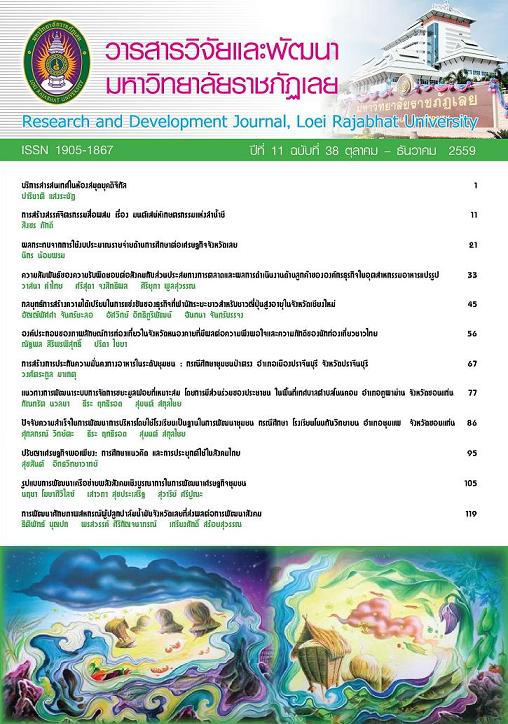รูปแบบการพัฒนาเครือข่ายพลังสังคมเชิงบูรณาการในการพัฒนาเศรษฐกิจชุมชน
Keywords:
การพัฒนาเครือข่าย, เครือข่ายพลังสังคม, พลังสังคมเชิงบูรณาการ, network development, social synergy network, integrated social synergy networkAbstract
บทคัดย่อ
การวิจัยมีวัตถุประสงค์ 1) เพื่อวิเคราะห์สภาพเครือข่ายพลังสังคมและแนวทางสร้างเครือข่ายพลังสังคมเชิงบูรณาการในการพัฒนาเศรษฐกิจชุมชนของอำเภอคอนสวรรค์ จังหวัดชัยภูมิ 2) เพื่อสร้างรูปแบบการพัฒนาเครือข่ายพลังสังคมเชิงบูรณาการ 3) เพื่อพัฒนาเครือข่ายพลังสังคมเชิงบูรณาการ และ 4) เพื่อประเมินความพึงพอใจและความเหมาะสมของรูปแบบการพัฒนาเครือข่ายพลังสังคมเชิงบูรณาการเป็นการวิจัยและพัฒนาโดยใช้ทั้งวิธีการศึกษาเชิงคุณภาพ เชิงปริมาณ และเชิงปฏิบัติการ กลุ่มเป้าหมาย คือ ประธาน รองประธาน กรรมการ สมาชิกเครือข่ายอาชีพรวม 200 คน รวบรวมข้อมูลโดยการสัมภาษณ์ การประชุมเชิงปฏิบัติการ การตรวจสอบรูปแบบโดยผู้ทรงคุณวุฒิ การประชุมเชิงปฏิบัติการแบบมีส่วนร่วม การประเมินความพึงพอใจและการประเมินความเหมาะสมของรูปแบบ เครื่องมือที่ใช้ได้แก่แบบสัมภาษณ์ แบบบันทึกการประชุมเชิงปฏิบัติการ และแบบสอบถาม แบบประเมิน การวิเคราะห์ข้อมูลใช้การวิเคราะห์เชิงเนื้อหา และสถิติเชิงบรรยาย ได้แก่ ค่าร้อยละ ค่าเฉลี่ย และส่วนเบี่ยงเบนมาตรฐาน
ผลการวิจัยสรุปได้ดังนี้
1. สภาพเครือข่ายพลังสังคมของกลุ่มอาชีพที่มีความหลากหลายของอำเภอคอนสวรรค์ ซึ่งเกิดจากการถ่ายทอด ภูมิปัญญาจากรุ่นสู่รุ่นมาตั้งแต่อดีตจนถึงปัจจุบัน และกลุ่มอาชีพที่เกิดจากการสนับสนุนส่งเสริมจากภาครัฐ โดยอาศัยหลักของการสร้างเครือข่ายเป็นตัวกำหนดโครงสร้างของกลุ่มแต่ละอาชีพในการขับเคลื่อนพัฒนา จึงเกิดเป็นแนวทางการสร้างเครือข่ายพลังสังคม ซึ่งประกอบด้วย 1) ด้านภาวะผู้นำ 2) ด้านความร่วมมือของสมาชิกกลุ่ม 3) การประสานงานของเครือข่าย 4) การติดต่อสื่อสารระหว่างเครือข่าย 5) การแลกเปลี่ยนเรียนรู้ระหว่างเครือข่าย 6) การเชื่อมโยงกิจกรรมการผลิตแบบครบวงจร 7) ภูมิปัญญาท้องถิ่น และ 8) ทุนทางสังคม นำมาบูรณาการในการพัฒนาสร้างเครือข่ายทางสังคมทำให้เกิดความเข้มแข็งมากขึ้น
2. รูปแบบการพัฒนาเครือข่ายพลังสังคมเชิงบูรณาการในการพัฒนาเศรษฐกิจชุมชน มีการดำเนินงานแบบมีส่วนร่วมในการประสานงาน การพิจารณาคัดเลือกผู้นำและสมาชิก การกำหนดรูปแบบการบริหารจัดการที่มีระบบชัดเจนด้วยการกำหนดเป้าหมายร่วมกันในแต่ละระดับ การกำหนดกิจกรรมพัฒนาเครือข่ายที่หลากหลายทำให้เกิดผลผลิตที่เป็นผลิตภัณฑ์และผลผลิตจากกลุ่มเครือข่ายแปลงสู่แผนการปฏิบัติในเชิงบูรณาการทำให้เกิดการพัฒนาด้านเศรษฐกิจชุมชนได้อย่างเป็นระบบ ส่งผลต่อการประเมินและตรวจสอบการปฏิบัติได้อย่างมีประสิทธิภาพมากขึ้น
3. การพัฒนาเครือข่ายพลังสังคมเชิงบูรณาการในการพัฒนาเศรษฐกิจชุมชน เป็นกระบวนการปฏิบัติตามขั้นตอนแผนการพัฒนาเครือข่ายอาชีพกลุ่มเป้าหมายสองอาชีพ โดยมีกิจกรรมพัฒนาตั้งแต่การคัดเลือกสมาชิก การวางแผนการพัฒนาร่วมกัน กำหนดกิจกรรมการพัฒนาในด้านการเรียนรู้การคัดเลือกสายพันธุ์ การเลี้ยงที่เป็นระบบจะช่วยเพิ่มประสิทธิภาพของผลผลิต การพัฒนาสร้างแนวคิดแปรรูปผลิตภัณฑ์ที่หลากหลาย เพื่อทำให้เกิดช่องทางเลือกและตลาดในการจำหน่ายเพิ่มมากขึ้น จึงส่งผลต่อการพัฒนาเครือข่ายพลังสังคมเชิงบูรณาการทำให้เกิดการพัฒนาเศรษฐกิจชุมชนในแต่ละระดับ
4.การประเมินความพึงพอใจและความเหมาะสมของรูปแบบการพัฒนาเครือข่ายพลังสังคมเชิงบูรณาการในการพัฒนาเศรษฐกิจชุมชน ด้านการสร้างเครือข่ายเชิงบูรณาการ กระบวนงานโครงการสร้างกลุ่มเครือข่าย พบว่า คณะกรรมการกลุ่มเครือข่ายมีความรู้ความสามารถเหมาะสมอยู่ในระดับมาก ( = 4.10) ด้านองค์ประกอบเครือข่าย พบว่า คณะกรรมการเครือข่ายมีความกระตือรืนร้น เอาใจใส่ในการให้บริการสมาชิกกลุ่มเครือข่ายอยู่ในระดับมาก ( = 4.20) ด้านการพัฒนาเศรษฐกิจชุมชน พบว่า สมาชิกได้รับการฝึกอบรมให้ความรู้เกี่ยวกับแนวคิดเศรษฐกิจชุมชน สมาชิกเครือข่ายสามารถประกอบอาชีพที่เหมาะสมอยู่ในระดับมาก ( = 4.42) และด้านสภาพแวดล้อม สถานที่ตั้งเครือข่าย พบว่า จัดสถานที่สำหรับการให้บริการสมาชิกได้อย่างเหมาะสมอยู่ในระดับมาก ( = 4.03) และผลการประเมินความเหมาะสมของรูปแบบการพัฒนาเครือข่ายพลังสังคม ส่งผลทำให้ก่อเกิดรูปแบบการพัฒนาศักยภาพความร่วมมือในระดับกลุ่มและเครือข่ายร่วมกัน โดยอาศัยภาวะผู้นำเป็นตัวขับเคลื่อนในการประสานงาน การมีส่วนร่วมในการบริหารจัดการทั้งการผลิตและการจำหน่ายที่มีคุณภาพ
Abstract
The purposes of this research were: 1) to analyze the conditions of social synergy networks and guidelines for building integrated social synergy networks for community economic development in Khonsawan District, Chaiyaphum Province; 2) to create a development model for integrated social synergy networks; 3) to develop an integrated social synergy network; and 4) to evaluate community satisfaction with and the appropriateness of the development model for integrated social synergy networks. The research applied qualitative, quantitative and action research approaches. The target group comprised 200 leaders, deputy leaders, committee members, and network members. Data was collected by means of interviews, a workshop, expert meetings, a participatory workshop, and the evaluation of model satisfaction and appropriateness. The instruments employed were interview schedules, workshop field notes, questionnaires and evaluation forms. Data was analyzed by means of content analysis and descriptive statistics (percentage, mean and standard deviation).
The results of the study were as follows:
1. The conditions of the social synergy network of the various occupational groups of Khonsawan District include the transfer of the wisdom from generation to generation, government support for occupation groups through village funds, and using network principles to determine the structure of each profession to drive development. The power of social networking is derived from the following factors: 1) leadership; 2) collaboration between members of the networking group; 3) networking coordination; 4) networking communication; 5) networking exchange; 6) fully cycled linkage of production activities; 7) local wisdom; and 8) social capital, which is greatly strengthened by integrated social networking.
2. The development model for integrated social synergy networks for community economic development comprises participatory operation and coordination, careful selection of leaders and members, defining a pattern of management with clearly determined common goals at each level, and identifying appropriate activities for a variety of aspects of network development. These factors facilitate productivity in the network, enable it to carry out integrative plans for systematic community economic development, and facilitate effective assessment and monitoring of compliance.
3. The development of integrated social synergy networks for the community economy involves a process of practice steps for the network development plan with two target occupation groups, namely producers of Mudmee silk and those involved in cattle and buffalo husbandry. The steps comprise the activity of the selected members, planning for common development, defining development activities for learning, selection of species, developing agricultural systems to enhance the efficiency of production, and the development of concepts for the private development of a variety of products to enhance marketing choice and increase sales. These steps result in the development of an integrated social synergy network to facilitate the development of a community economy at each level.
4. The evaluation of community satisfaction with and the suitability of the development model for integrated social synergy networks for community economy development involved integrated networking. This process of networking found that the boards of networking groups have appropriate competencies (with a high score of 4.10). With regard to network elements, it was found that network boards are diligent in paying attention to serving members of the network (with a high score of 4.20). With regard to community economy development, it was found that members have been educated about the community economy concept (with a high score of 4.42). With regard to the environment of the network location, it was found that management of the venue for service members was conducted appropriately (with a high score of 4.03). Finally, the results of the assessment of the development model for integrated social synergy networks gave rise to a model of cooperative competency development in groups and sharing networks based on leadership in driving coordination and participation in management and quality production distribution.
Downloads
How to Cite
Issue
Section
License
ข้อความที่ปรากฎในวารสารฉบับนี้เป็นความคิดเห็นของผู้เขียนแต่ละท่าน สถาบันวิจัยและพัฒนา มหาวิทยาลัยราชภัฏเลย และกองบรรณาธิการ ไม่จำเป็นต้องเห็นด้วยและไม่มีส่วนรับผิดชอบใดๆ
สถาบันวิจัยและพัฒนา มหาวิทยาลัยราชภัฏเลย ขอให้ผู้อ่านอ้างอิงในกรณีที่ท่านคัดลอกเนื้อหาบทความในวารสารฉบับนี้






